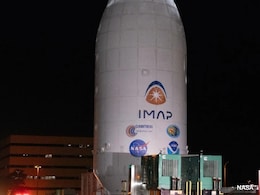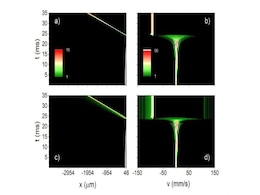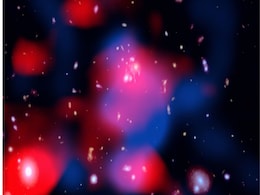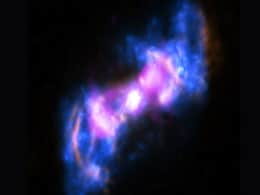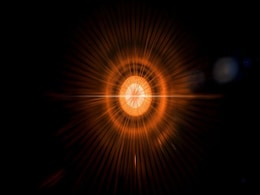Cosmic Rays
- All
- News
- Videos
-

JWST Spots Most Distant Supernova Ever, From 730 Million Years After Big Bang
- Monday December 29, 2025
- Written by Gadgets 360 Staff
Scientists have confirmed the most distant supernova ever observed, exploding just 730 million years after the Big Bang. Detected through a powerful gamma-ray burst and later verified by the James Webb Space Telescope, the event offers a rare glimpse of the deaths of the universe’s first stars during the era of reionisation and challenges expecta...
-
 www.gadgets360.com
www.gadgets360.com
-

NASA Uses 'X-arithmetic' to Show How Black Holes Shape Galaxy Clusters
- Friday December 12, 2025
- Science | Edited by Nikhil Pandey
NASA's Chandra telescope has used a novel "X-arithmetic" technique to analyse X-ray data from galaxy clusters, showing how supermassive black holes influence hot gas structures and offering new insights into cosmic evolution.
-
 www.ndtv.com
www.ndtv.com
-

X-Ray Nebula Discovery Brings Astronomers Closer to Solving Cosmic Ray Mystery
- Friday November 28, 2025
- Written by Gadgets 360 Staff
A new study has linked an unexplained LHAASO detection to a pulsar-powered X-ray nebula, confirming it as a rare PeVatron capable of accelerating particles to extreme energies. The discovery is a major step toward solving the long-standing mystery of galactic cosmic rays. Researchers are now combining X-ray, gamma-ray and neutrino observations to t...
-
 www.gadgets360.com
www.gadgets360.com
-

Scientists Recreate Cosmic ‘Fireballs’ in Lab to Solve Mystery of Missing Gamma Rays
- Wednesday November 5, 2025
- Written by Gadgets 360 Staff
Scientists recreated cosmic plasma beams at CERN to study why certain gamma rays vanish in space. The results showed the beams remain stable, suggesting ancient intergalactic magnetic fields, not beam collapse, hide the signals. The discovery provides new insight into cosmic jets and the universe’s earliest magnetic traces.
-
 www.gadgets360.com
www.gadgets360.com
-

Saturn’s Icy Moon Enceladus Organic Molecules May Have Been Fromed by Cosmic Rays, Scientists Find
- Monday October 27, 2025
- Written by Gadgets 360 Staff
Laboratory experiments reveal that radiation striking Saturn’s icy moon Enceladus can create simple organic molecules, reshaping how scientists interpret Cassini’s data and highlighting radiation’s key role in the chemistry of icy moons.
-
 www.gadgets360.com
www.gadgets360.com
-

What Is Heliosphere? NASA's New Mission To Study Sun's Protective Bubble
- Thursday September 25, 2025
- Science | Edited by NDTV News Desk
NASA launched the Interstellar Mapping and Acceleration Probe (IMAP) spacecraft from Kennedy Space Center in Florida on Wednesday, September 24.
-
 www.ndtv.com
www.ndtv.com
-

Scientists Explore Role of Space Radiation in Powering Alien Microbial Life
- Wednesday August 6, 2025
- Written by Gadgets 360 Staff
A new study proposes that life may exist far from sunlight in a “radiolytic habitable zone” deep beneath the icy surfaces of Mars, Europa, and Enceladus. Cosmic rays, which can penetrate rock and ice, break water molecules apart to release hydrogen, oxygen, and energy-rich electrons. These can fuel microbes in subsurface water, much like bacter...
-
 www.gadgets360.com
www.gadgets360.com
-

Scientists Recreate Cosmic Ray Physics Using Cold Atom in New Laboratory Study
- Friday July 11, 2025
- Written by Gadgets 360 Staff
Scientists have successfully recreated Fermi acceleration in a lab using ultracold atoms and movable optical barriers, simulating how cosmic rays gain energy in space. Developed by teams from Birmingham and Chicago, the mini Fermi accelerator marks a major advance in particle physics, opening doors to high-energy astrophysics studies and innovation...
-
 www.gadgets360.com
www.gadgets360.com
-

Most Distant Mini-Halo Discovered in Galaxy Cluster 10 Billion Light-Years Away
- Monday June 30, 2025
- Written by Gadgets 360 Staff
Astronomers have uncovered the most distant mini-halo ever detected, located around the galaxy cluster SpARCS1049, a staggering 10 billion light-years from Earth. Using the LOFAR radio telescope network, which spans eight European countries, researchers detected a faint, diffuse glow—evidence of a giant cloud of high-energy particles and magnetic...
-
 www.gadgets360.com
www.gadgets360.com
-

New Study Confirms TeV Halos Are Common in Middle-Aged Pulsars
- Thursday May 22, 2025
- Written by Gadgets 360 Staff
A recent study by researchers from the U.S. and Mexico using data from the HAWC Observatory has confirmed that TeV halos are a universal feature of middle-aged pulsars. These extended regions of gamma-ray emission are significantly larger than pulsar wind nebulae and may help identify otherwise undetectable pulsars. The findings challenge existing ...
-
 www.gadgets360.com
www.gadgets360.com
-

The Universe’s Brightest Lights Have Surprisingly Dark and Mysterious Origins
- Saturday May 3, 2025
- Written by Gadgets 360 Staff
NASA’s Fermi Gamma-ray Space Telescope has revealed that some of the universe’s brightest light sources originate near supermassive black holes in galaxy centres. These active galactic nuclei emit intense radiation, including gamma rays and X-rays, despite black holes themselves being invisible. Their powerful jets and high-energy emissions cha...
-
 www.gadgets360.com
www.gadgets360.com
-

New Study Uncovers Shadowy Origins of Universe’s Most Luminous Phenomena
- Friday May 2, 2025
- Written by Gadgets 360 Staff
NASA’s Fermi Gamma-ray Space Telescope has revealed that some of the universe’s brightest light sources originate near supermassive black holes in galaxy centres. These active galactic nuclei emit intense radiation, including gamma rays and X-rays, despite black holes themselves being invisible. Their powerful jets and high-energy emissions cha...
-
 www.gadgets360.com
www.gadgets360.com
-

Scientists Detects Most Energetic Neutrino Ever in the Mediterranean Sea
- Friday February 14, 2025
- Written by Gadgets 360 Staff
A record-breaking neutrino with 220 quadrillion electron volts has been detected in the Mediterranean Sea. Captured by the KM3NeT deep-sea telescope, this rare cosmic event could be linked to powerful astrophysical phenomena such as black holes or supernovae. Neutrinos, nearly massless particles that rarely interact with matter, provide crucial ins...
-
 www.gadgets360.com
www.gadgets360.com
-

AMS Data Reveals Charged Particle Variations in Heliosphere Over Solar Cycle
- Monday February 10, 2025
- Written by Gadgets 360 Staff
Researchers analysing AMS data aboard the ISS have identified variations in charged particles within the heliosphere over an 11-year solar cycle. Shifts in the heliospheric magnetic field impact antiproton behaviour and cosmic nuclei fluxes, revealing correlations between solar modulation and cosmic ray movement. AMS measurements provide insights i...
-
 www.gadgets360.com
www.gadgets360.com
-

JWST Spots Most Distant Supernova Ever, From 730 Million Years After Big Bang
- Monday December 29, 2025
- Written by Gadgets 360 Staff
Scientists have confirmed the most distant supernova ever observed, exploding just 730 million years after the Big Bang. Detected through a powerful gamma-ray burst and later verified by the James Webb Space Telescope, the event offers a rare glimpse of the deaths of the universe’s first stars during the era of reionisation and challenges expecta...
-
 www.gadgets360.com
www.gadgets360.com
-

NASA Uses 'X-arithmetic' to Show How Black Holes Shape Galaxy Clusters
- Friday December 12, 2025
- Science | Edited by Nikhil Pandey
NASA's Chandra telescope has used a novel "X-arithmetic" technique to analyse X-ray data from galaxy clusters, showing how supermassive black holes influence hot gas structures and offering new insights into cosmic evolution.
-
 www.ndtv.com
www.ndtv.com
-

X-Ray Nebula Discovery Brings Astronomers Closer to Solving Cosmic Ray Mystery
- Friday November 28, 2025
- Written by Gadgets 360 Staff
A new study has linked an unexplained LHAASO detection to a pulsar-powered X-ray nebula, confirming it as a rare PeVatron capable of accelerating particles to extreme energies. The discovery is a major step toward solving the long-standing mystery of galactic cosmic rays. Researchers are now combining X-ray, gamma-ray and neutrino observations to t...
-
 www.gadgets360.com
www.gadgets360.com
-

Scientists Recreate Cosmic ‘Fireballs’ in Lab to Solve Mystery of Missing Gamma Rays
- Wednesday November 5, 2025
- Written by Gadgets 360 Staff
Scientists recreated cosmic plasma beams at CERN to study why certain gamma rays vanish in space. The results showed the beams remain stable, suggesting ancient intergalactic magnetic fields, not beam collapse, hide the signals. The discovery provides new insight into cosmic jets and the universe’s earliest magnetic traces.
-
 www.gadgets360.com
www.gadgets360.com
-

Saturn’s Icy Moon Enceladus Organic Molecules May Have Been Fromed by Cosmic Rays, Scientists Find
- Monday October 27, 2025
- Written by Gadgets 360 Staff
Laboratory experiments reveal that radiation striking Saturn’s icy moon Enceladus can create simple organic molecules, reshaping how scientists interpret Cassini’s data and highlighting radiation’s key role in the chemistry of icy moons.
-
 www.gadgets360.com
www.gadgets360.com
-

What Is Heliosphere? NASA's New Mission To Study Sun's Protective Bubble
- Thursday September 25, 2025
- Science | Edited by NDTV News Desk
NASA launched the Interstellar Mapping and Acceleration Probe (IMAP) spacecraft from Kennedy Space Center in Florida on Wednesday, September 24.
-
 www.ndtv.com
www.ndtv.com
-

Scientists Explore Role of Space Radiation in Powering Alien Microbial Life
- Wednesday August 6, 2025
- Written by Gadgets 360 Staff
A new study proposes that life may exist far from sunlight in a “radiolytic habitable zone” deep beneath the icy surfaces of Mars, Europa, and Enceladus. Cosmic rays, which can penetrate rock and ice, break water molecules apart to release hydrogen, oxygen, and energy-rich electrons. These can fuel microbes in subsurface water, much like bacter...
-
 www.gadgets360.com
www.gadgets360.com
-

Scientists Recreate Cosmic Ray Physics Using Cold Atom in New Laboratory Study
- Friday July 11, 2025
- Written by Gadgets 360 Staff
Scientists have successfully recreated Fermi acceleration in a lab using ultracold atoms and movable optical barriers, simulating how cosmic rays gain energy in space. Developed by teams from Birmingham and Chicago, the mini Fermi accelerator marks a major advance in particle physics, opening doors to high-energy astrophysics studies and innovation...
-
 www.gadgets360.com
www.gadgets360.com
-

Most Distant Mini-Halo Discovered in Galaxy Cluster 10 Billion Light-Years Away
- Monday June 30, 2025
- Written by Gadgets 360 Staff
Astronomers have uncovered the most distant mini-halo ever detected, located around the galaxy cluster SpARCS1049, a staggering 10 billion light-years from Earth. Using the LOFAR radio telescope network, which spans eight European countries, researchers detected a faint, diffuse glow—evidence of a giant cloud of high-energy particles and magnetic...
-
 www.gadgets360.com
www.gadgets360.com
-

New Study Confirms TeV Halos Are Common in Middle-Aged Pulsars
- Thursday May 22, 2025
- Written by Gadgets 360 Staff
A recent study by researchers from the U.S. and Mexico using data from the HAWC Observatory has confirmed that TeV halos are a universal feature of middle-aged pulsars. These extended regions of gamma-ray emission are significantly larger than pulsar wind nebulae and may help identify otherwise undetectable pulsars. The findings challenge existing ...
-
 www.gadgets360.com
www.gadgets360.com
-

The Universe’s Brightest Lights Have Surprisingly Dark and Mysterious Origins
- Saturday May 3, 2025
- Written by Gadgets 360 Staff
NASA’s Fermi Gamma-ray Space Telescope has revealed that some of the universe’s brightest light sources originate near supermassive black holes in galaxy centres. These active galactic nuclei emit intense radiation, including gamma rays and X-rays, despite black holes themselves being invisible. Their powerful jets and high-energy emissions cha...
-
 www.gadgets360.com
www.gadgets360.com
-

New Study Uncovers Shadowy Origins of Universe’s Most Luminous Phenomena
- Friday May 2, 2025
- Written by Gadgets 360 Staff
NASA’s Fermi Gamma-ray Space Telescope has revealed that some of the universe’s brightest light sources originate near supermassive black holes in galaxy centres. These active galactic nuclei emit intense radiation, including gamma rays and X-rays, despite black holes themselves being invisible. Their powerful jets and high-energy emissions cha...
-
 www.gadgets360.com
www.gadgets360.com
-

Scientists Detects Most Energetic Neutrino Ever in the Mediterranean Sea
- Friday February 14, 2025
- Written by Gadgets 360 Staff
A record-breaking neutrino with 220 quadrillion electron volts has been detected in the Mediterranean Sea. Captured by the KM3NeT deep-sea telescope, this rare cosmic event could be linked to powerful astrophysical phenomena such as black holes or supernovae. Neutrinos, nearly massless particles that rarely interact with matter, provide crucial ins...
-
 www.gadgets360.com
www.gadgets360.com
-

AMS Data Reveals Charged Particle Variations in Heliosphere Over Solar Cycle
- Monday February 10, 2025
- Written by Gadgets 360 Staff
Researchers analysing AMS data aboard the ISS have identified variations in charged particles within the heliosphere over an 11-year solar cycle. Shifts in the heliospheric magnetic field impact antiproton behaviour and cosmic nuclei fluxes, revealing correlations between solar modulation and cosmic ray movement. AMS measurements provide insights i...
-
 www.gadgets360.com
www.gadgets360.com






